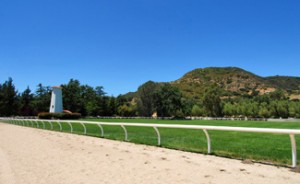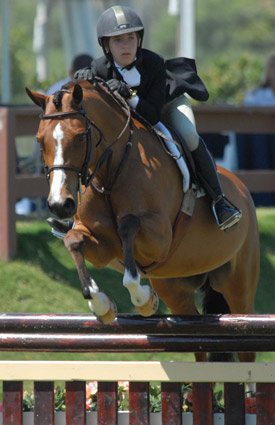By Jackie McFarland
Bernie Traurig’s Equestrian Coach
We are deep into a new age where knowledge is literally at our fingertips. From connecting to collecting, the wealth of available resources awaits the typing of a simple address. Not your physical address, but the uniform resource locator or URL. That string of characters – www-dot-equestriancoach-dot-com – represents a wide world of people that are now reaching one another in ways that were virtually impossible just over a decade ago.
Although the equestrian niche certainly utilizes these resources – email, texting, web sites, Facebook, Google, PayPal – a select group have considered the possibilities of this vast network, combined it with their own bank of experience and connections to create an opportunity not previously available. One such individual is Bernie Traurig, the force behind the recently launched EquestrianCoach.com.

SOME HISTORY
First, step back in equestrian time and take note that Traurig has an extensive breadth of knowledge and success. Having achieved the top level of competition in all three of the International Equestrian Olympic disciplines: show jumping, dressage and eventing, Traurig has over half a century of experience to share.
Renowned not only for his riding talents, but for his teaching and coaching gifts as well, Traurig has been a member of the United States Equestrian Team in both the US and abroad. Still actively involved, he is currently George Morris’s Associate Chef d’ Equipe to the United States Equestrian Team on the West Coast.
SOMETHING FOR EVERYONE
Previous to the Internet age, the opportunities to learn from the masters meant proximity, perseverance and reaching deep in your pockets to pay for clinics, lessons, even DVDs and books. Several years ago, Traurig recognized that modern technology gave him a medium to ‘train’ anyone who wanted to learn.
By providing educational video clips by a list of top-level trainers, anyone at any level and at any time could watch and learn. What a great way to offer expertise for a reasonable price. Instead of going to the experts, they can now come to you.
SOME TIME
After discovering these exciting possibilities, then came the long road of developing the web site. Conceptually the plan was a go and seemingly straight forward, but there were a multitude of steps to take before completion.
Gaining excitement by introducing the concept at the 2009 FEI World Cup in Las Vegas, the EquestrianCoach.com team had their work cut out for them. Filming, editing, generating content, creating a web site flow, pricing model and programming were just a few of the tasks. In the process, Traurig developed clips by show jumping greats such as Olympic Gold Medalist Will Simpson, USHJA International Hunter Derby Finals Winner John French, world class level competitor Rich Fellers and equitation expert Missy Clark as well as dressage and eventing stars Debbie McDonald, Gina Miles and Michael Plumb. The site also offers building blocks and clinics provided by Traurig. And that is just the beginning, more experts are lined up to participate.
Traurig comments with a smile, “I kept thinking we would be ready to go and then we would want to tweak something or realized we could make it better. It was and is an intense time commitment, but it’s so great to see it come together.”

Other sections include endorsements from George Morris and Paul Cronin, grassroots and horsemanship, a Kids Corner, interviews with coaches and the list continues to grow.
On June 1, 2010 all the preparing, planning and processing became a reality when EquestrianCoach.com officially launched.
SENSATIONAL and SENSIBLE
Before the World Wide Web, the fundamental information that EquestrianCoach.com provides was only available to the sport’s elite. The site serves as a coaching aid to riders and trainers alike and aims to make quality education accessible and affordable to every equestrian, regardless of background, level of riding or geographic location.
Now riders from anywhere in the world can take lessons from top trainers. Even a high level rider can gain a new perspective for a very reasonable price.
For less than what it would cost to take a clinic from one of the masters presented on the site, a subscriber can purchase an annual pass of educational videos for a special introductory offer of $299. Or for significantly less than one training lesson, buy a monthly subscription and learn from several top trainers for just $29.99.
“One of the best parts is the chance to offer education to such a wide audience,” explained Traurig. “All the work is well worthwhile when I know how many riders could benefit.”
TAKE A TEST RIDE WITH EQUESTRIAN COACH
Besides a tutorial, there are a handful of clips available for free viewing as well as an FAQ section to answer all your questions. You can look at the options in the video library plus see a list of what’s coming next. What could be better for your virtual library than some of the world’s best riders and trainers just a click away and for less than a dollar a day?
 El Campeon is certainly the home of champions. The multi-faceted farm continues to host clinics, film sets and commercial shoots, and without question is one of the finest equestrian facilities in California, if not beyond.
El Campeon is certainly the home of champions. The multi-faceted farm continues to host clinics, film sets and commercial shoots, and without question is one of the finest equestrian facilities in California, if not beyond. Knowing the expansive beauty of Sandstone, when I sat down to discuss the details, my first question was why go horse show when you can ride at Sandstone every day? Mark answered with a laugh, “It is majestic and quite lovely. Ideal as a training facility. That’s just it, you can win a lot of classes at home, but to see what you’ve accomplished through all the training happens at the horse show.” And you’ll always be glad to come home again!
Knowing the expansive beauty of Sandstone, when I sat down to discuss the details, my first question was why go horse show when you can ride at Sandstone every day? Mark answered with a laugh, “It is majestic and quite lovely. Ideal as a training facility. That’s just it, you can win a lot of classes at home, but to see what you’ve accomplished through all the training happens at the horse show.” And you’ll always be glad to come home again!